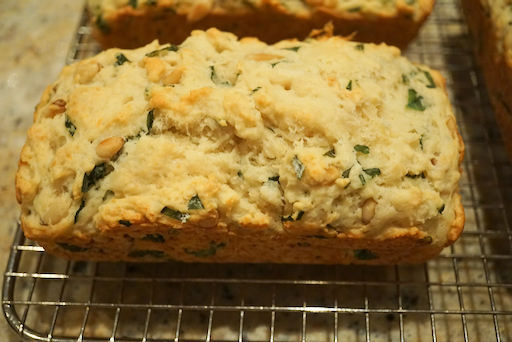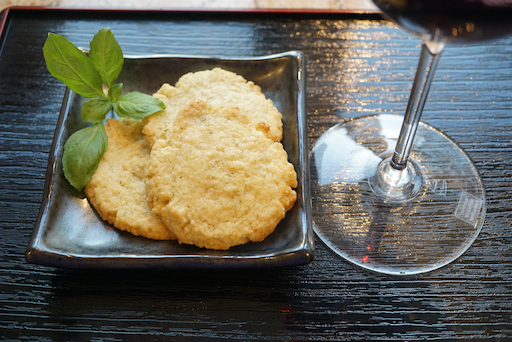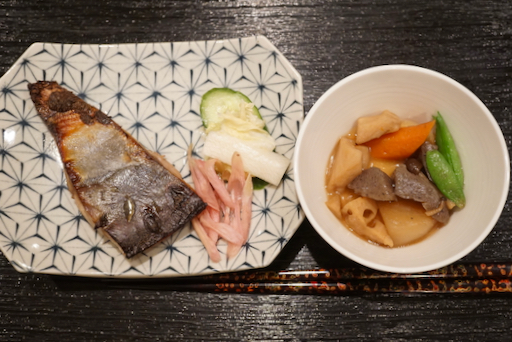Wednesday, December 16, 2020
Cuttlefish legs with simmered vegetables イカの足いり根菜の煮付け
Monday, December 14, 2020
Sushi Taro "regular" kaiseki box "普通”の寿司太郎会席弁当
Friday, December 11, 2020
Basil and pine nuts quick bread バジルと松の実の速成パン
My wife made this quick bread as an effort to use more of the basil we are growing in our windowsill herb garden. In addition to the basil, it has pine nuts and parmesan cheese. So it is a kind-of disaggregated “pesto” bread. This is a savory quick bread which is good for breakfast or even as an hors d’oeuvre with wine.

Tuesday, December 8, 2020
Lemon basil shortbread cookie レモンバジルクッキー
We had this with DAOU Vineyards Pessimist Red Blend 2018 which is Petit syrah based. Our recent favorite/house wine.
Ingredients: (18 cookies)
1 cup AP flour
1/2 cup sugar
1/2 cup unsalted butter, cold, cut into pieces
2 tbs sliced basil (or more to taste)
grated zest from one lemon
1/4 tsp kosher salt
Directions:
Preheat oven to 375F
Line cookie sheet with parchment paper
Add all ingredients to the food processor and mix (#1)
Using a small ice cream scoop, portion out the dough (#2)
Bake 7-8 minutes at 375F (#4)
Let cool on a cooling rack
The lemon flavors come through strongly contrasts nicely with the sweetness and is pleasantly refreshing. After one day in the refrigerator, the basil flavor began to surface more strongly. Somehow this cookie went well with the red wine we were having. My wife has made quite a good variety of savory cookies. This is another good one.
Saturday, December 5, 2020
Renkon salad 蓮根サラダ
Ingredients: (amounts are all arbitrary)
Fresh renkon, skinned and cut into wedge-shaped bite-size chunks (called “rangeri” 乱切りby cutting on bias, turn 45 degree again cutting on bias.
Boil it in water with a splash of rice vinegar for 10 minutes, drain and let cool.
Blanched broccoli floret and skinned Campari tomato.
Dressing:
1tbs Hellman’s mayonnaise
1 tsp of Yuzu juice (from the bottle)
This dressing tastes really similar to the commercial Yuzu mayonnaise we bought recently. This combination of vegetables works well—the nice crunchy texture of renkon and slightly less crunchy broccoli.
Wednesday, December 2, 2020
Renkon balls レンコンまんじゅう
This dish is the result of an unexpected “silver lining” derived from the Covid epidemic. Because of Covid, we decided as a safety precaution, not to go to the grocery store but rather have groceries delivered. This forced us out of our usual routines and by necessity introduced us to new options. One of which was buying groceries from HMart Korean grocery store via the Instacart. As a benefit, we are now getting items which were not available from our usual grocery stores. One such item is fresh “reckon” 蓮根 or lotus root. (It is the floating stalk, not the root of a water lily). Even at our Japanese grocery store, the only reckon we could get was cleaned, boiled and sold in a package. It is easier to use than fresh renkon but it limits the dishes that can be made from it. For example, I could not have made this renkon ball or dumpling dish レンコンまんじゅう shown below from packaged prepared renkon. But with fresh renkon available I could. I served the dumplings in a very gentle broth, with garnishes of edamame 枝豆, and simply fried reckon slices.
Instructions for the renkon balls
Ingredients:
One segment of fresh renkon (#1) (after grated, #4, it was slightly more than 700grams)
2 tbs potato starch
3 large shrimp, thawed, shell removed and cut into small chunks then salted
10-15 shelled edamame
For broth
1 cup kelp and bonito broth (I used a dashi pack)
1 tbs of white dashi “shirt-dashi” 白だし seasoning or 1tbs each mirin and light colored soy sauce (or to taste).
Directions:
One segment of fresh renkon (#1).
Remove the ends of the segment of renkon and peel the skin (#2 and #3)
Finely grate the renkon and drain to remove excess moisture (#4)
Mix in the corn starch, shrimp and edamame. Make small balls about one inch in diameter.
Deep fry at 300-320 F for 7-10 minutes (#5)
Drain (#6)
Assembly:
I cut one renkon ball in half and placed the halves in a bowl. I added the fried renkon and edamame and poured in the hot broth. You can also reheat everything in the broth and serve.
This is a very good dish. The contrast of elastic texture of the renkon balls and crunchy fried renkon is wonderful. The shrimp has similar texture to the renkon ball and since it was salted, it imparts briny salty burst of flavors. I made the broth very gentle and light which also went well.
Sunday, November 29, 2020
Yellowtail marinaded in sake lee ハマチの粕漬け
This was the last of the whole fresh yellowtail. I marinated the filet in sake lee 酒粕 or "Kasu-zuke" 粕漬け. Since I did not have a time to cook this during the week, the fish marinated for a week which was a bit too long. I also made Japanese stewed vegetable "nituske" 煮付け as a side.

Ingredients:
Sake lee 300grams
Red miso 30grams
Sugar 3 tbs
Salt 1/2 tsp
Sake to loosen up the marinade if too stiff,
Directions:
I added half of the sake lee mixture in the bottom of a sealable container and placed cheese cloth (after washing to remove any lint). I put in the filets and then covered them with another layer of cheese cloth. I put the remaining sake lee mixture on top. I let it marinate in the refrigerator (for a week as it turned out).
This was a bit over-marinated. I started broiling on the flesh side first as shown below in the toaster oven.

























